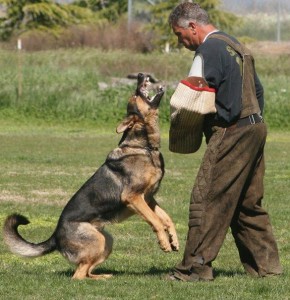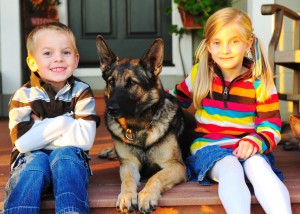What Makes A Good Protection Dog?

This Schutzhund-titled dog guards John Riboni very convincingly, demonstrating willingness to confront a threat. Photo by Cindy Alves.
What makes a good protection dog? This is a common question people ask. For many people, the terms “guard dog” and “protection dog” are synonymous with snarling, barking, lunging dogs with snapping teeth and shady temperaments. The phrase “elite protection dog” has emerged in an attempt to differentiate between common “guard dogs” and highly trained “executive protection dogs”. But even with this “elite protection dog” distinction, there are still many misconceptions as to what constitutes a good protection dog.
Good protection dogs should have stable temperaments, natural confidence, loyalty to family, high trainability, and a willingness and ability to engage a threat when necessary. The foundation for all of these qualities is genetic; these traits must be selectively bred for and tested in breeding stock and their offspring. This is one reason why German Shepherd Watchdogs selects their family protection dogs from Schutzhund-trained and titled German Shepherd Dogs. In order to successfully achieve a Schutzhund or IPO title, the dog must undergo a temperament test and rigorous training in obedience, tracking, and protection work. These working titles help test and demonstrate each dog’s temperament, trainability, confidence, and willingness to engage a threat. The training to achieve these titles also develops self-control in the dog, and develops handler control over the dog.
Temperament cannot be stressed enough when it comes to good protection dogs. Many people mistakenly think that dogs who bark at everything and everyone, or who fly into a fit of aggressive behavior when anyone walks by the car or house, are good ‘guard dogs’. But this type of behavior can indicate a dog that is overly suspicious, nervous, anxious, or fearful; they view everything as a personal threat to their safety, and react aggressively out of worry and self-preservation. An overly reactive dog with a weak temperament does not make a good protection dog; they view everyone as a foe, and may end up biting indiscriminately. Or, they may be too fearful to truly commit during a threat; they put on a spectacular display, but that is all it is–a display with no courage or fight behind it.

A good protection dog has a stable, confident temperament with good discrimination, watchfulness, and natural protectiveness.
A good protection dog should have a stable, confident temperament with good discrimination, watchfulness, and natural protectiveness. The foundation for this type of temperament is genetic, and it is then built upon through socialization and training. Dogs with solid, stable temperaments will typically be quiet and calm in public, confident in their surroundings, watchful but unconcerned with normal everyday occurrences. Good protection dogs may show aloof behavior toward strangers, but are not aggressive toward strangers displaying normal, non-threatening behaviors.
A good protection dog should be highly trainable. Some breeds of “guard dogs” show natural, overt aggression and suspicion toward strangers, but are difficult to train due to their independent, stubborn nature. This type of dog is a liability, because they are not under the handler’s direct control. Breeds like the German Shepherd Dog are very intelligent and easy to train, and they have the ability to be trained to a very high level. They show a natural aptitude for working with the handler. These genetic qualities are what help make a good protection dog.


I am a woman living alone in St. George, Ut. I am looking for a trained companion
who is friendly and stable. I have a large yard.
Can you advise how much such a dog would cost? I would not object to an older adult.